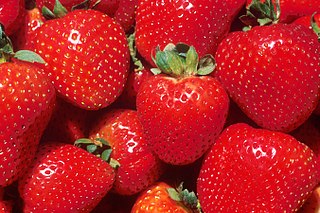
Red is the color at the long wavelength end of the visible spectrum of light, next to orange and opposite violet. It has a dominant wavelength of approximately 625–740 nanometres. It is a primary color in the RGB color model and a secondary color in the CMYK color model, and is the complementary color of cyan. Reds range from the brilliant yellow-tinged scarlet and vermillion to bluish-red crimson, and vary in shade from the pale red pink to the dark red burgundy.

Violet is the color of light at the short wavelength end of the visible spectrum, between blue and invisible ultraviolet. It is one of the seven colors that Isaac Newton labeled when dividing the spectrum of visible light in 1672. Violet light has a wavelength between approximately 380 and 435 nanometers. The color's name is derived from the violet flower.

Brown is a color. It can be considered a composite color, but it is mainly a darker shade of orange. In the CMYK color model used in printing and painting, brown is usually made by combining the colors orange and black. In the RGB color model used to project colors onto television screens and computer monitors, brown combines red and green.

Orange is the colour between yellow and red on the spectrum of visible light. Human eyes perceive orange when observing light with a dominant wavelength between roughly 585 and 620 nanometres. In traditional colour theory, it is a secondary colour of pigments, produced by mixing yellow and red. In the RGB colour model, it is a tertiary colour. It is named after the fruit of the same name.
Carmine – also called cochineal, cochineal extract, crimson lake, or carmine lake – is a pigment of a bright-red color obtained from the aluminium complex derived from carminic acid. Specific code names for the pigment include natural red 4, C.I. 75470, or E120. Carmine is also a general term for a particularly deep-red color.

Vermilion is a color family and pigment most often used between antiquity and the 19th century from the powdered mineral cinnabar. It is synonymous with red orange, which often takes a modern form, but is 11% brighter.

Cat coat genetics determine the coloration, pattern, length, and texture of feline fur. Understanding how can be challenging because many genes are involved. The variations among cat coats are physical properties and should not be confused with cat breeds. A cat may display the coat of a certain breed without actually being that breed. For example, a Neva Masquerade could wear point coloration, the stereotypical coat of a Siamese.

John La Farge was an American artist whose career spanned illustration, murals, interior design, painting, and popular books on his Asian travels and other art-related topics.
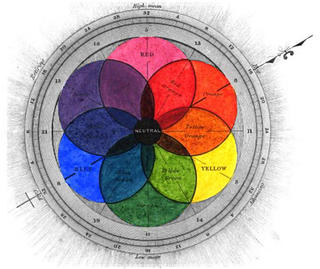
RYB is a subtractive color model used in art and applied design in which red, yellow, and blue pigments are considered primary colors. Under traditional color theory, this set of primary colors was advocated by Moses Harris, Michel Eugène Chevreul, Johannes Itten and Josef Albers, and applied by countless artists and designers. The RYB color model underpinned the color curriculum of the Bauhaus, Ulm School of Design and numerous art and design schools that were influenced by the Bauhaus, including the IIT Institute of Design, Black Mountain College, Design Department Yale University, the Shillito Design School, Sydney, and Parsons School of Design, New York.

Orpiment is a deep-colored, orange-yellow arsenic sulfide mineral with formula As
2S
3. It is found in volcanic fumaroles, low-temperature hydrothermal veins, and hot springs and is formed both by sublimation and as a byproduct of the decay of another arsenic sulfide mineral, realgar.

Trinity Church in the City of Boston, located in the Back Bay neighborhood of Boston, Massachusetts is a parish of the Episcopal Diocese of Massachusetts. The congregation, currently standing at approximately 4,000 households, was founded in 1733. Five services are offered each Sunday, and weekday services are offered three times a week from September through June. Within the spectrum of worship styles in the Anglican tradition, Trinity Church has historically been considered a Broad Church parish.

Scarlet is a bright red color, sometimes with a slightly orange tinge. In the spectrum of visible light, and on the traditional color wheel, it is one-quarter of the way between red and orange, slightly less orange than vermilion.

The blood orange is a variety of orange with crimson, near blood-colored flesh.
Heins & LaFarge was a New York-based architectural firm composed of the Philadelphia-born architect George Lewis Heins (1860–1907) and Christopher Grant LaFarge (1862–1938), the eldest son of the artist John La Farge. They were responsible for the original Romanesque-Byzantine east end and crossing of the Cathedral of St. John the Divine, New York, and for the original Astor Court buildings of the Bronx Zoo, which formed a complete ensemble reflecting the aesthetic of the City Beautiful movement. Heins & LaFarge provided the architecture and details for the Interborough Rapid Transit Company, the first precursor to the New York City Subway.

The Adams Memorial is a grave marker for Marian Hooper Adams and Henry Adams located in Section E of Rock Creek Cemetery, Washington, D.C. The memorial features a cast bronze allegorical sculpture by Augustus Saint-Gaudens. Saint-Gaudens' shrouded-figure statue is seated against a granite block which takes up one side of a hexagonal plaza, designed by architect Stanford White. Across from the statue is a stone bench for visitors. The whole is sheltered by a close screen of dense conifers.

Many New York City Subway stations are decorated with colorful ceramic plaques and tile mosaics. Of these, many take the form of signs, identifying the station's location. Much of this ceramic work was in place when the subway system originally opened on October 27, 1904. Newer work continues to be installed each year, much of it cheerful and fanciful.

Varieties of the color red may differ in hue, chroma or lightness, or in two or three of these qualities. Variations in value are also called tints and shades, a tint being a red or other hue mixed with white, a shade being mixed with black. A large selection of these various colors are shown below.
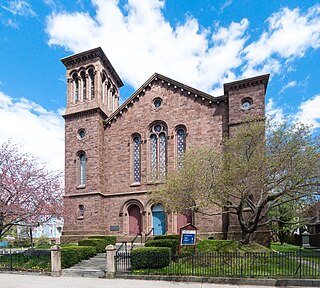
The United Congregational Church is a historic former church building in Newport, Rhode Island. The congregation was formerly affiliated with the United Church of Christ (UCC). Built in 1857, the church was designated a National Historic Landmark in 2012, in recognition for the unique interior decorations executed in 1880–81 by John La Farge.
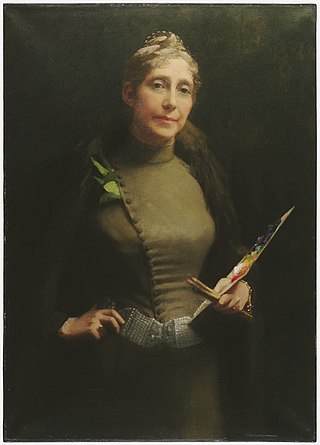
Sarah de St. Prix Wyman Whitman (1842–1904) was an American stained glass artist, painter, and book cover designer. Successful at a time when few women had professional art careers, she founded her own firm, Lily Glass Works. Her stained glass windows are found in churches and colleges throughout the northeastern United States. As a member of the board of the Harvard University "Annex," she helped to found Radcliffe College.
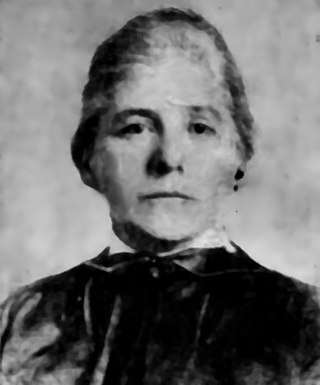
Margaret Redmond (1867–1948) was an American stained glass artist. Her work is characteristic of the medieval revival style, inspired by the fourteenth and fifteenth century stained glass of French and English cathedrals. She chose innovative glass materials, vibrant colors and thick leading designs for her windows, favored by the leading stained glass artists of the Arts and Crafts Movement in England. She is best known for her stained glass work from the 1920s to the 1940s, which can be found in churches, museums, homes and libraries from New Jersey to Maine.

















